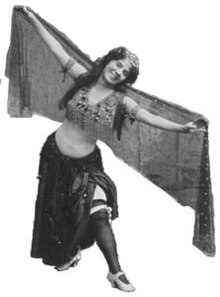The ghawazee of were travelling female dancers of Dom (Gypsy) ethnicity in Egypt during the 18th to 19th centuries. They were banished from Cairo to Upper Egypt by Muhammad Ali in the 1830s. [1] The dance style of the ghawazee was popularized in Europe under the term "belly-dance" in 19th-century Orientalism. Around this time, dancers from the Middle East also began to perform at various World's Fairs, often drawing crowds in numbers that rivaled those for the science and technology exhibits. It was during this period that the term "oriental" or "eastern" dancing is first used. Several dancers, including the French author Colette, engaged in "oriental" dancing, sometimes passing off their own interpretations as authentic. Also the pseudo-Javanese dancer Mata Hari, convicted in 1917 by the French for being a German spy, danced in a style similar to belly dance.
The ghawazee were made famous in Europe by writers such as Gerard de Nerval (1808-1855) and Gustav Flaubert (1821-1880). The French painter Jean-Léon Gérôme (1824-1904) executed a series of paintings depicting them, the best known among these was L'Almée or Le danse the ventre, which caused considerable scandal at the Salon of 1864 in Paris, and sent other painters to Egypt in the search of "belly-dance". In 1881, the Austrian painter Leopold Carl Müller was given an audience with Crown Prince Rudolf of Austria in Girga in Upper Egypt. Müller in a letter to his friend August von Pettenkofen expressed his intrigue, saying "...and in the evening we saw Egyptian dancers. One should use Gérôme for an example! I am so curious to know what Gérôme would do if he were here."[Müller and Gérôme shared the same dealer in London, Henry Wallis, and had exhibited paintings at his French Gallery in the Pall Mall. Müller's depiction of an Egyptian dancer, titled An Almée's Admirers, was exhibited there in 1882.
In the early 20th century, the urban Egyptian raqs sharqi style developed, based on ghawazi and other folk styles and formed by western influences such as marching bands, the Russian ballet, Latin dance, etc. This hybrid style was performed in the cabarets of interbellum period Egypt and in early Egyptian cinema.

